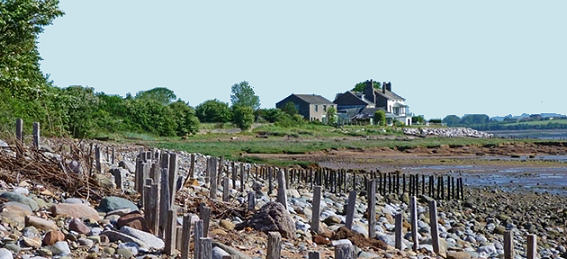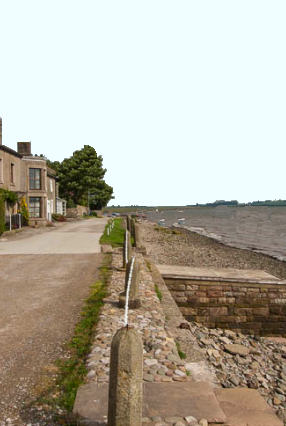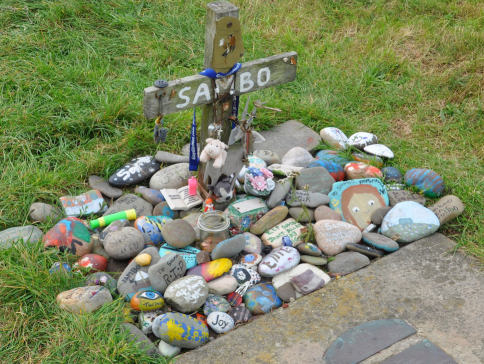Sunderland Point
OS Grid ref:- SD426562
 Sunderland Point is a unique village of around 30 houses and farms at the end of a windswept tidal causeway between the mouth of the River Lune and Morecambe Bay. Sunder or asunder means apart and when the tide comes in the village is cut off from the mainland.
Sunderland Point is a unique village of around 30 houses and farms at the end of a windswept tidal causeway between the mouth of the River Lune and Morecambe Bay. Sunder or asunder means apart and when the tide comes in the village is cut off from the mainland.
It was once used as a port serving cotton, sugar and slave ships from the West Indies and North America, but its importance declined as other ports such as Lancaster were opened. Sunderland Point was developed as an out port for Lancaster in the early eighteenth century by a Quaker named Robert Lawson and it is has been claimed that the first cotton crop to enter Britain arrived here. It is also said that stonework from the ruined Cockersand Abbey which lies across the river was used to build the quay. Lawson went bankrupt in 1728, which saw the steady decline of Sunderland Point until it was totally surpassed by Glasson Dock, which opened in 1787. Ships could unload here, or wait for the tide before moving up to the main docks at St. Georges Quay in Lancaster and registering at the Customs House.
 There are a number of fine Georgian buildings along the quay , one of which is a former hostelry. Sunderland Hall was built by Robert and Elizabeth Pearson and bears the inscription REP 1683. There is also an early eighteenth century gatepier on the quay. The views over the River Lune are superb, the village featured in the TV drama 'The Ruby in the Smoke' in 2006. The only vehicular access to Sunderland Point is by a single-track road crossing a tidal marsh, flooded at high tide, from the village of Overton which lies 1.5 miles (2.4 km) away.
There are a number of fine Georgian buildings along the quay , one of which is a former hostelry. Sunderland Hall was built by Robert and Elizabeth Pearson and bears the inscription REP 1683. There is also an early eighteenth century gatepier on the quay. The views over the River Lune are superb, the village featured in the TV drama 'The Ruby in the Smoke' in 2006. The only vehicular access to Sunderland Point is by a single-track road crossing a tidal marsh, flooded at high tide, from the village of Overton which lies 1.5 miles (2.4 km) away.
For almost two hundred years a 'cotton tree' grew at Sunderland Point. It finally fell on New Year's Day, 1998 during a fierce storm that did much damage along the west coast. A section of the trunk remains in front of the cottage where it grew . It is believed that it may have been a Kapok tree which is native to the West Indies and could have seeded itself from some imported matter, or been planted.
Lancaster, once the third largest port in the country, was part of the slavery triangle. The master of a slave or servant called Sambo from West Africa left him at Sunderland Point whilst he travelled on to Lancaster to carry out business. Sambo died in 1736 in the old brewery, perhaps of a European disease to which he had no immunity. The Lonsdale Magazine of 1822 records:-
'After she had discharged her cargo, he was placed at the inn ... with the intention of remaining there on board wages till the vessel was ready to sail; but supposing himself to be deserted by the master, without being able, probably from his ignorance of the language, to ascertain the cause, he fell into a complete state of stupefaction, even to such a degree that he secreted himself in the loft on the brewhouses and stretching himself out at full length on the bare boards refused all sustenance. He continued in this state only a few days, when death terminated the sufferings of poor Samboo. As soon as Samboo’s exit was known to the sailors who happened to be there, they excavated him in a grave in a lonely dell in a rabbit warren behind the village, within twenty yards of the sea shore, whither they conveyed his remains without either coffin or bier, being covered only with the clothes in which he died'
 The old brewery still stands on the corner of the pathway that leads to his grave. Sambo's Grave on the unconsecrated (as he was not a Christian) and windswept shoreline of Morecambe Bay is still a local tourist attraction today. For a long time the grave was unmarked, until some sixty years later a retired schoolmaster discovered the story and raised some money for a memorial. He also wrote the epitaph that now marks the grave:-
The old brewery still stands on the corner of the pathway that leads to his grave. Sambo's Grave on the unconsecrated (as he was not a Christian) and windswept shoreline of Morecambe Bay is still a local tourist attraction today. For a long time the grave was unmarked, until some sixty years later a retired schoolmaster discovered the story and raised some money for a memorial. He also wrote the epitaph that now marks the grave:-
'Full many a Sand-bird chirps upon the Sod
And many a moonlight Elfin round him trips
Full many a Summer's Sunbeam warms the Clod
And many a teeming cloud upon him drips.
But still he sleeps -- till the awakening Sounds
Of the Archangel's Trump now life impart
Then the GREAT JUDGE his approbation founds
Not on man's COLOUR but his worth of heart.'
The grave, a poignant reminder of Lancashire's involvement in the slave trade, almost always bears flowers or stones painted by the local children. To reach Sambo's Grave follow a signed path that leads inland from the shingle foresore at Sunderland Point and eventually to the west shore. Passes several houses and a small church to arrive at a metal gate. Turn left after passing through the gate, the grave is in a small walled area about a couple of hundred yards along the shore.
When visiting beware of fast moving tides in this area, which cover the road.
Nearby places of interest
Cockersand Abbey founded before 1184 as the Hospital of St Mary on the marsh belonging to Leicester Abbey and known as St Marys in the Marsh.
Lancaster Castle founded in the tenth century
Ashton Memorial in Williamson Park, Lancaster was commissioned by James Williamson, Baron Ashton as a tribute to his second wife, Jenny and was built between 1907 and 1909.
Butterfly House, Lancaster
